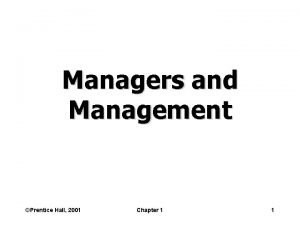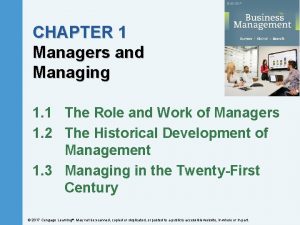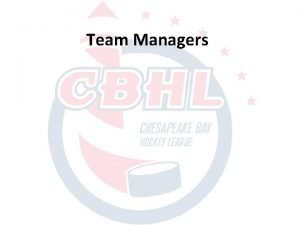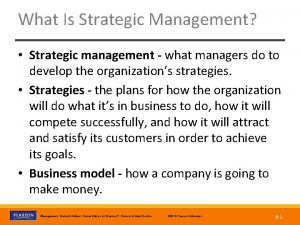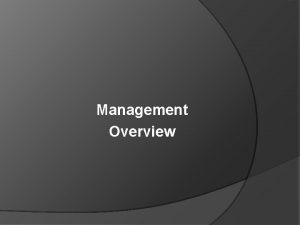Chapter 3 The Managers Role in Strategic Human















- Slides: 15

Chapter 3 The Manager’s Role in Strategic Human Resource Management Part One | Introduction Copyright © 2011 Pearson Education, Inc. publishing as Prentice Hall Power. Point Presentation by Charlie Cook The University of West Alabama

Why Strategic Planning Is Important To All Managers • The firm’s strategic plan guides much of what is done by all to accomplish organizational goals. • Decisions made by managers depend on the goals set at each organizational level in support of higher level goals. Copyright © 2011 Pearson Education, Inc. publishing as Prentice Hall 3– 2

Fundamentals of Management Planning The Planning Process 1 Set an objective. 2 Make forecasts and check assumptions. 3 Determine/develop alternative courses of action. 4 Evaluate the alternatives. 5 Implement and evaluate your plan. Copyright © 2011 Pearson Education, Inc. publishing as Prentice Hall 3– 3

How Managers Set Objectives: SMART Goals S Specific M Measureable A Attainable R Relevant T Timely Copyright © 2011 Pearson Education, Inc. publishing as Prentice Hall 3– 4

How to Set Motivational Goals Motivational Goal Setting Assign specific goals Assign measurable goals Copyright © 2011 Pearson Education, Inc. publishing as Prentice Hall Assign challenging but doable goals Encourage employee participation 3– 5

Using Management by Objectives (MBO) The MBO Process 1 Set overall organizational goals. 2 Set departmental (supporting) goals. 3 Discuss departmental goals with subordinates. 4 Set individual goals and timetables. 5 Give feedback on progress toward goal. Copyright © 2011 Pearson Education, Inc. publishing as Prentice Hall 3– 6

The Strategic Management Process • Strategy Ø A course of action the organization intends to pursue to achieve its strategic aims. • Strategic Plan Ø How an organization intends to match its internal strengths and weaknesses with its external opportunities and threats to maintain a competitive advantage over the long term. • Strategic Management Ø The process of identifying and executing the organization’s mission by matching its capabilities with the demands of its environment. Copyright © 2011 Pearson Education, Inc. publishing as Prentice Hall 3– 7

Business Vision and Mission • Vision Ø A general statement of an organization’s intended direction that evokes emotional feelings in organization members. • Mission Ø Spells out who the firm is, what it does, and where it’s headed. Copyright © 2011 Pearson Education, Inc. publishing as Prentice Hall 3– 8

FIGURE 3– 5 The Strategic Management Process Copyright © 2011 Pearson Education, Inc. publishing as Prentice Hall 3– 9

FIGURE 3– 8 Type of Strategy at Each Company Level Copyright © 2011 Pearson Education, Inc. publishing as Prentice Hall 3– 10

Types of Corporate Strategies Corporate Strategy Possibilities Diversification Concentration Vertical integration Copyright © 2011 Pearson Education, Inc. publishing as Prentice Hall Consolidation Geographic expansion 3– 11

Types of Competitive Strategies Business-Level Competitive Strategies Cost leadership Differentiation Copyright © 2011 Pearson Education, Inc. publishing as Prentice Hall Focus/Niche 3– 12

Strategic Human Resource Management • Strategic Human Resource Management Ø The linking of HRM with strategic goals and objectives in order to improve business performance and develop organizational cultures that foster innovation and flexibility. Ø Involves formulating and executing HR systems—HR policies and activities—that produce the employee competencies and behaviors that the company needs to achieve its strategic aims. Copyright © 2011 Pearson Education, Inc. publishing as Prentice Hall 3– 13

FIGURE 3– 10 Linking Company-Wide and HR Strategies Copyright © 2011 Pearson Education, Inc. publishing as Prentice Hall 3– 14

Building A High-Performance Work System • High-Performance Work System (HPWS) Ø A set of human resource management policies and practices that promote organizational effectiveness. • High-Performance Human Resource Policies and Practices Ø Emphasize the use of relevant HR metrics. Ø Set out the things that HR systems must do to become an HPWS. Ø Foster practices that encourage employee self-management. Ø Practice benchmarking to set goals and measure the notable performance differences required of an HPWS. Copyright © 2011 Pearson Education, Inc. publishing as Prentice Hall 3– 15
 Why strategic planning is important to all managers
Why strategic planning is important to all managers What is web role and worker role in azure
What is web role and worker role in azure Symbolischer interaktionismus krappmann
Symbolischer interaktionismus krappmann Role conflict occurs when fulfilling the role expectations
Role conflict occurs when fulfilling the role expectations Strategic fit vs strategic intent
Strategic fit vs strategic intent Strategic substitutes and strategic complements
Strategic substitutes and strategic complements Strategic competitiveness
Strategic competitiveness Analysing the 6 strategic options megxit
Analysing the 6 strategic options megxit Chapter 1 management
Chapter 1 management Managers and management chapter 1
Managers and management chapter 1 A carefully developed overall approach to leading
A carefully developed overall approach to leading Cna chapter 8 human needs and human development
Cna chapter 8 human needs and human development Chapter 8 human needs and human development
Chapter 8 human needs and human development Importance of modifiers of human acts
Importance of modifiers of human acts Applied psychology in human resource management
Applied psychology in human resource management Hát kết hợp bộ gõ cơ thể
Hát kết hợp bộ gõ cơ thể









